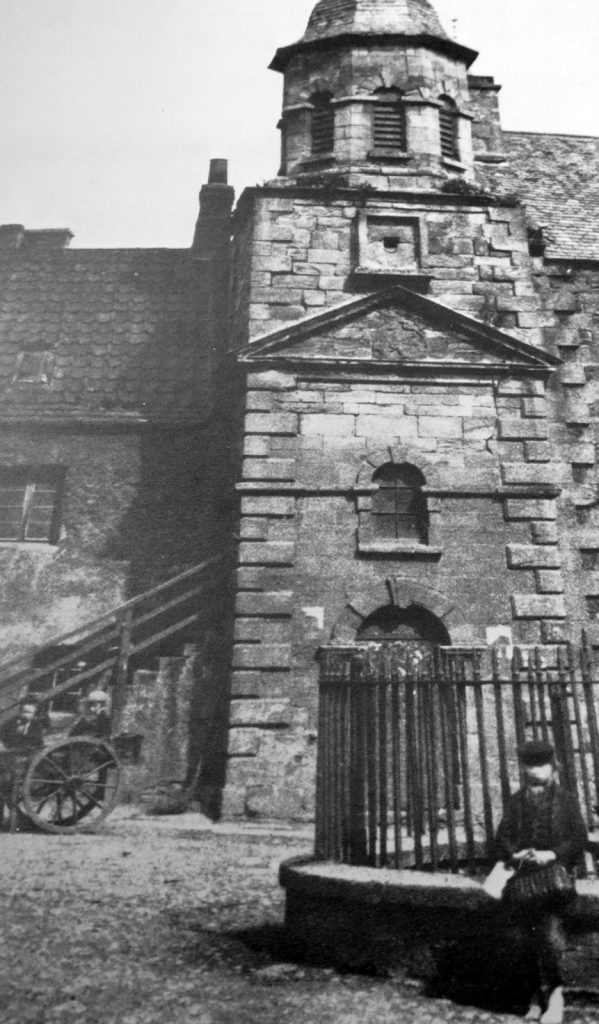
Sandy Stevenson, Tour Scotland
Walter Bruce (died 1673) was the minister at the Scottish parish of Inverkeithing and Rosyth in Fife from 1641 until his death in 1673. A controversial character frequently subjected to admonishment by his church superiors, he was a key figure in the witch-hunt of 1649 to 1650.
His pastoral duties often suffered as he devoted time to zealously seeking out persons committing acts of witchcraft in the area. The deep rift his actions provoked in the community may have led to the number of substantial complaints made to the presbytery against him.
The minister at one of the neighbouring parishes, Aberdour, was his older sibling, Robert Bruce. His brother was also a keen hunter of witches but failed to match the zeal exhibited by his contemporary at Inverkeithing.
Family and education
A member of a higher-status landed family,[1] he was a younger son of Sir John Bruce of Kincavil[a]Kincavil is now Kingscavil, an area to the east of Linlithgow.[2][3] and his wife Jean Drummond. Educated at St Andrews University, he graduated with a masters degree in 1628. He was ordained sometime before 1641.[4]
In May 1664 Bruce married Jean (died February 1691[5]), a daughter of Alexander Menzies of Rotmell.[4][b]William Ross gives her name as Joanna indicating she was the sister of Robert Menzies of Rotmell who was the eldest son and heir of Alexander Menzies of Rotmell.[6][7] After Walter Bruce’s death she became the fourth wife of John Liddell, the minister at Scone.[5] Jean brought a dowry of 2,500 merks to the marriage but in June 1670 Bruce was seeking court action against his father-in-law and brother-in-law for non-payment of the monies.[7][c]A Scots merk was equivalent to 13 shillings 4d.[8]
Bruce’s precise date of death is not known but occurred between 20 February and 5 March 1673.[4]
Clergyman
Bruce was appointed minister at Inverkeithing and Rosyth by the Synod in 1641.[4] As a cleric he was a controversial figure: despite being a minister, he was involved in several business ventures, including shared ownership of a ship; participation in commercial dealings was considered inappropriate for members of the clergy.[9]
During 1649, Bruce claimed that he had insufficient time to attend to sick parishioners due to “the sicknes and deathe of some off his freinds’ elsewhere.”[10] He was also chastised for using indiscreet language during church services;[4] swearing regularly featured as a part of his vocabulary.[11] Modern day academic Peter Maxwell-Stuart attributes Bruce’s spell of suspension from ministerial duties in 1649 to “giving voice to some slightly crackpot notions from his pulpit.”[12] In March of that year Bruce was criticised by the presbytery for delivering a sermon and reciting prayers at a witch’s execution.[13]
Then in 1650 the Dunfermline presbytery demoted him for “gross neglects of the special duties of his ministry”.[9] Bruce appealed, and the General Assembly permitted him to resume preaching in December 1652. A further admonishment was issued to him by the moderator in 1653.[4]
Conforming to Episcopacy in 1653, he became Constant Moderator in the same year.[4] While some parishioners agreed with the overall approach Bruce took against witchcraft many others were concerned over his actions; this may explain why he was the subject of so many complaints to his superiors that led to admonishments.[9]
Witch-hunter
The Inverkeithing minister played a significant role in what was to develop into the witchcraft panic of 1649 to 1650.[14] The witch-hunt spread to neighbouring parishes including Aberdour[15] where Robert Bruce, Walter’s older brother, was the minister.[3] Robert also had a keen interest in seeking out witches[16] but did not display quite as much of an unbridled fervour towards the task as employed by his younger sibling.[17]
By July 1649 Bruce was involved in accusations of witchcraft against at least twenty-three Inverkeithing locals, some of whom were married to magistrates.[9] Margaret Henderson, Lady PittadroMember of the Scottish elite who was accused then incarcerated for witchcraft in 1649, but died before her case went to trial. was named as the ringleader of the witches. One of the group, Margaret Blaikburn,[d]sometimes given as Blaikburne elaborated in her confession that Lady Pittadro had summoned them to a meeting to lodge complaints with the Devil about the Inverkeithing minister.[18] Testimony given to Bruce asserted that Lady Pittadro wanted help getting retribution from the Devil against him after he purchased a house she wished to buy for her daughter and son-in-law. Lady Pittadro was wealthy and, like Bruce, came from a higher-status landed family.[14]
The main thrust of the witch-hunt was in 1649 with it coming to an abrupt end in 1650.[19] Lady Pittadro had the highest profile of all Walter Bruce’s victims.[14]
Notes
| a | Kincavil is now Kingscavil, an area to the east of Linlithgow.[2][3] |
|---|---|
| b | William Ross gives her name as Joanna indicating she was the sister of Robert Menzies of Rotmell who was the eldest son and heir of Alexander Menzies of Rotmell.[6][7] After Walter Bruce’s death she became the fourth wife of John Liddell, the minister at Scone.[5] |
| c | A Scots merk was equivalent to 13 shillings 4d.[8] |
| d | sometimes given as Blaikburne |
